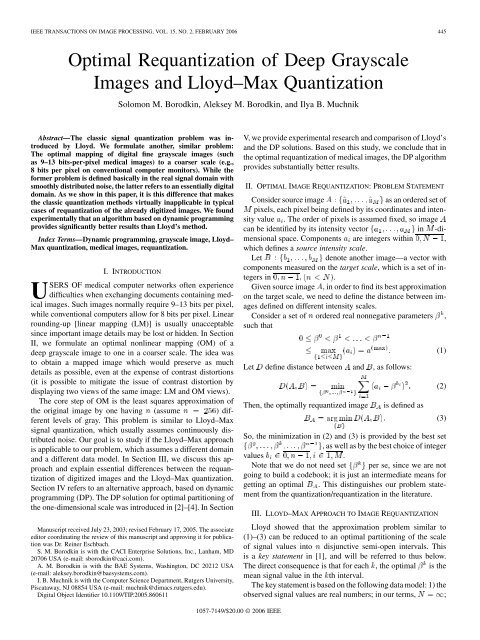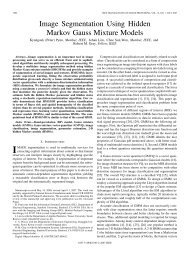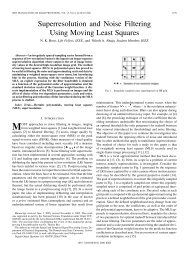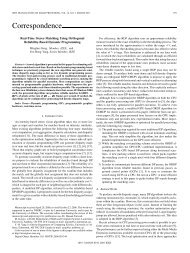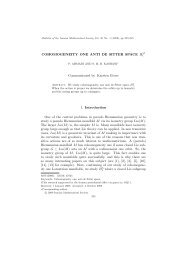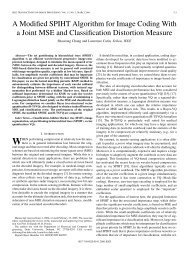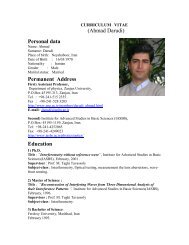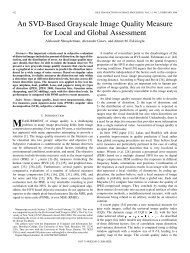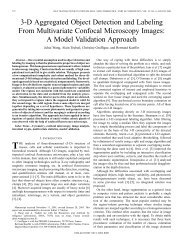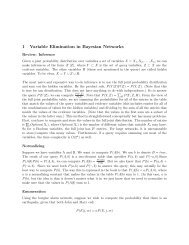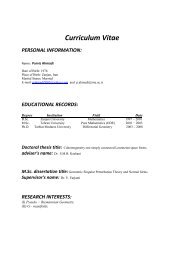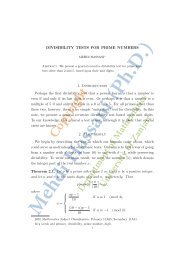Optimal requantization of deep grayscale images and Lloyd-Max ...
Optimal requantization of deep grayscale images and Lloyd-Max ...
Optimal requantization of deep grayscale images and Lloyd-Max ...
Create successful ePaper yourself
Turn your PDF publications into a flip-book with our unique Google optimized e-Paper software.
IEEE TRANSACTIONS ON IMAGE PROCESSING, VOL. 15, NO. 2, FEBRUARY 2006 445<br />
<strong>Optimal</strong> Requantization <strong>of</strong> Deep Grayscale<br />
Images <strong>and</strong> <strong>Lloyd</strong>–<strong>Max</strong> Quantization<br />
Solomon M. Borodkin, Aleksey M. Borodkin, <strong>and</strong> Ilya B. Muchnik<br />
Abstract—The classic signal quantization problem was introduced<br />
by <strong>Lloyd</strong>. We formulate another, similar problem:<br />
The optimal mapping <strong>of</strong> digital fine <strong>grayscale</strong> <strong>images</strong> (such<br />
as 9–13 bits-per-pixel medical <strong>images</strong>) to a coarser scale (e.g.,<br />
8 bits per pixel on conventional computer monitors). While the<br />
former problem is defined basically in the real signal domain with<br />
smoothly distributed noise, the latter refers to an essentially digital<br />
domain. As we show in this paper, it is this difference that makes<br />
the classic quantization methods virtually inapplicable in typical<br />
cases <strong>of</strong> <strong>requantization</strong> <strong>of</strong> the already digitized <strong>images</strong>. We found<br />
experimentally that an algorithm based on dynamic programming<br />
provides significantly better results than <strong>Lloyd</strong>’s method.<br />
Index Terms—Dynamic programming, <strong>grayscale</strong> image, <strong>Lloyd</strong>–<br />
<strong>Max</strong> quantization, medical <strong>images</strong>, <strong>requantization</strong>.<br />
I. INTRODUCTION<br />
USERS OF medical computer networks <strong>of</strong>ten experience<br />
difficulties when exchanging documents containing medical<br />
<strong>images</strong>. Such <strong>images</strong> normally require 9–13 bits per pixel,<br />
while conventional computers allow for 8 bits per pixel. Linear<br />
rounding-up [linear mapping (LM)] is usually unacceptable<br />
since important image details may be lost or hidden. In Section<br />
II, we formulate an optimal nonlinear mapping (OM) <strong>of</strong> a<br />
<strong>deep</strong> <strong>grayscale</strong> image to one in a coarser scale. The idea was<br />
to obtain a mapped image which would preserve as much<br />
details as possible, even at the expense <strong>of</strong> contrast distortions<br />
(it is possible to mitigate the issue <strong>of</strong> contrast distortion by<br />
displaying two views <strong>of</strong> the same image: LM <strong>and</strong> OM views).<br />
The core step <strong>of</strong> OM is the least squares approximation <strong>of</strong><br />
the original image by one having (assume ) different<br />
levels <strong>of</strong> gray. This problem is similar to <strong>Lloyd</strong>–<strong>Max</strong><br />
signal quantization, which usually assumes continuously distributed<br />
noise. Our goal is to study if the <strong>Lloyd</strong>–<strong>Max</strong> approach<br />
is applicable to our problem, which assumes a different domain<br />
<strong>and</strong> a different data model. In Section III, we discuss this approach<br />
<strong>and</strong> explain essential differences between the <strong>requantization</strong><br />
<strong>of</strong> digitized <strong>images</strong> <strong>and</strong> the <strong>Lloyd</strong>–<strong>Max</strong> quantization.<br />
Section IV refers to an alternative approach, based on dynamic<br />
programming (DP). The DP solution for optimal partitioning <strong>of</strong><br />
the one-dimensional scale was introduced in [2]–[4]. In Section<br />
Manuscript received July 23, 2003; revised February 17, 2005. The associate<br />
editor coordinating the review <strong>of</strong> this manuscript <strong>and</strong> approving it for publication<br />
was Dr. Reiner Eschbach.<br />
S. M. Borodkin is with the CACI Enterprise Solutions, Inc., Lanham, MD<br />
20706 USA (e-mail: sborodkin@caci.com).<br />
A. M. Borodkin is with the BAE Systems, Washington, DC 20212 USA<br />
(e-mail: aleksey.borodkin@baesystems.com).<br />
I. B. Muchnik is with the Computer Science Department, Rutgers University,<br />
Piscataway, NJ 08854 USA (e-mail: muchnik@dimacs.rutgers.edu).<br />
Digital Object Identifier 10.1109/TIP.2005.860611<br />
V, we provide experimental research <strong>and</strong> comparison <strong>of</strong> <strong>Lloyd</strong>’s<br />
<strong>and</strong> the DP solutions. Based on this study, we conclude that in<br />
the optimal <strong>requantization</strong> <strong>of</strong> medical <strong>images</strong>, the DP algorithm<br />
provides substantially better results.<br />
II. OPTIMAL IMAGE REQUANTIZATION: PROBLEM STATEMENT<br />
Consider source image<br />
as an ordered set <strong>of</strong><br />
pixels, each pixel being defined by its coordinates <strong>and</strong> intensity<br />
value . The order <strong>of</strong> pixels is assumed fixed, so image<br />
can be identified by its intensity vector in -dimensional<br />
space. Components are integers within ,<br />
which defines a source intensity scale.<br />
Let<br />
denote another image—a vector with<br />
components measured on the target scale, which is a set <strong>of</strong> integers<br />
in .<br />
Given source image , in order to find its best approximation<br />
on the target scale, we need to define the distance between <strong>images</strong><br />
defined on different intensity scales.<br />
Consider a set <strong>of</strong> ordered real nonnegative parameters ,<br />
such that<br />
Let define distance between <strong>and</strong> , as follows:<br />
Then, the optimally requantized image<br />
is defined as<br />
So, the minimization in (2) <strong>and</strong> (3) is provided by the best set<br />
, as well as by the best choice <strong>of</strong> integer<br />
values .<br />
Note that we do not need set per se, since we are not<br />
going to build a codebook; it is just an intermediate means for<br />
getting an optimal . This distinguishes our problem statement<br />
from the quantization/<strong>requantization</strong> in the literature.<br />
III. LLOYD–MAX APPROACH TO IMAGE REQUANTIZATION<br />
<strong>Lloyd</strong> showed that the approximation problem similar to<br />
(1)–(3) can be reduced to an optimal partitioning <strong>of</strong> the scale<br />
<strong>of</strong> signal values into disjunctive semi-open intervals. This<br />
is a key statement in [1], <strong>and</strong> will be referred to thus below.<br />
The direct consequence is that for each , the optimal is the<br />
mean signal value in the th interval.<br />
The key statement is based on the following data model: 1) the<br />
observed signal values are real numbers; in our terms, ;<br />
(1)<br />
(2)<br />
(3)<br />
1057-7149/$20.00 © 2006 IEEE
446 IEEE TRANSACTIONS ON IMAGE PROCESSING, VOL. 15, NO. 2, FEBRUARY 2006<br />
2) infinite number <strong>of</strong> samples; in our case, the number <strong>of</strong> pixels,<br />
(specifically in [1], that follows from the Nyquist theorem);<br />
3) the observed signal values differ from certain true<br />
values by additive <strong>and</strong> relatively smoothly distributed noise.<br />
Although it was not said explicitly, an ideal data model would<br />
have been defined by a continuous <strong>and</strong> strictly increasing cumulative<br />
distribution function (c.d.f.), . A good example might<br />
be a mixture <strong>of</strong> normal distributions<br />
where factors account for normalization <strong>and</strong> probabilities <strong>of</strong><br />
different quanta .<br />
In [1], the problem was stated for the c.d.f. <strong>of</strong> general<br />
type; however, any deviation from the continuity <strong>and</strong> strictly<br />
increasing behavior was considered a nonessential <strong>and</strong> merely<br />
technical complication. This might be acceptable when the ideal<br />
data model assumption was true in the major part <strong>of</strong> domain. It<br />
is usually the case for the quantization <strong>of</strong> analog signals.<br />
Practically, signal measurement always eventually results in<br />
conversion to digital form; so, we can assume a finite number <strong>of</strong><br />
initial quanta (speaking more accurately, a number <strong>of</strong> distinct<br />
initial quanta <strong>of</strong> nonzero probability). In order for the model to<br />
be close to the analog case, the following two inequalities should<br />
take place:<br />
where the left one would make the interval include many initial<br />
quanta, so the probability <strong>of</strong> any particular value <strong>of</strong> the signal<br />
would be negligible; the right one would make a histogram close<br />
to the true distribution density.<br />
In case <strong>of</strong> image <strong>requantization</strong>, e.g., if<br />
, at least the first inequality<br />
in (5) is not true. It is a combinatorial, rather than a regular<br />
optimization, problem. The c.d.f. has discontinuity in each<br />
integer<br />
, <strong>and</strong> intervals <strong>of</strong> constancy in between.<br />
There is no one “regular” (in terms <strong>of</strong> the ideal model) point at<br />
all in the entire domain. Hence, it is a different problem.<br />
The first consequence <strong>of</strong> this difference is that the pro<strong>of</strong> <strong>of</strong> the<br />
<strong>Lloyd</strong>’s key statement cannot be fully extrapolated to the digital<br />
image domain, because the special case <strong>of</strong> the signal value exactly<br />
at the boundary point (midway between the two adjacent<br />
quanta) is ignored. It was ignored in [1] <strong>and</strong> in later literature<br />
(e.g., [5, p. 176]). This is acceptable in the analog case, where<br />
any single value can be treated as one <strong>of</strong> probabilistic measure<br />
zero. In case <strong>of</strong> image <strong>requantization</strong>, endpoints with nonzero<br />
probability are quite possible. Therefore, it is important which<br />
<strong>of</strong> the two adjacent intervals the boundary intensity will be assigned<br />
to, according to optimal partitioning. Even more important<br />
is the question: Could part <strong>of</strong> the corresponding pixels belong<br />
to the left interval, while the rest belong to the right one?<br />
Had this split been possible, the key statement would not have<br />
been true in the digital domain.<br />
The answer cannot be obtained using <strong>Lloyd</strong>’s reasoning; a<br />
different <strong>and</strong> independent pro<strong>of</strong> <strong>of</strong> this statement in the digital<br />
domain is required. In [6], we showed in particular, that<br />
the optimality in (1)–(3) could never be reached with a “split<br />
end-point”:If is the optimal <strong>requantization</strong> <strong>of</strong> , then for any<br />
(4)<br />
(5)<br />
pair <strong>of</strong> pixel indices<br />
; the last implication means that pixels with<br />
equal intensity values cannot fall in the different intervals.<br />
The second consequence <strong>of</strong> the difference between the classic<br />
quantization <strong>and</strong> image <strong>requantization</strong> relates to the algorithms.<br />
While <strong>Lloyd</strong>’s key statement, with the above extension, holds<br />
true for the problem (1)–(3), both quantization methods in [1]<br />
face serious difficulties in the digital domain.<br />
The basic idea <strong>of</strong> both heuristic solution methods in [1] is<br />
that the endpoint between adjacent intervals is always midway<br />
between the corresponding quanta<br />
(6)<br />
Method I starts with r<strong>and</strong>om partition<br />
. Each<br />
quantum is calculated as an average <strong>of</strong> the signal values in<br />
the th interval. Then, the endpoints <strong>of</strong> the intervals are adjusted<br />
according to (6), <strong>and</strong> the quanta are recalculated again. The iterations<br />
continue until a certain stopping criterion is met.<br />
Method II starts with r<strong>and</strong>om value ; endpoint <strong>of</strong> the first<br />
interval is calculated to make an average in the first interval<br />
. Then, quantum is calculated to satisfy condition<br />
(6); endpoint <strong>of</strong> the second interval is calculated to make<br />
an average in , <strong>and</strong> so forth. If the last quantum in this<br />
sequence differs from the average signal value in the last interval<br />
by more than certain threshold , the process restarts from<br />
a new initial value . The process stops when the difference between<br />
<strong>and</strong> the average in the last interval does not exceed .<br />
Obviously, (6) is not sufficient for optimality, so the algorithms<br />
usually stop in the local minima. Moreover, it is not necessary,<br />
either, because optimal intervals may be separated not<br />
only by endpoints (6), but also by separating intervals (SIs)<br />
<strong>of</strong> nonzero length <strong>and</strong> probability 0. In our case, every SI has<br />
length <strong>of</strong> at least 1. Any point <strong>of</strong> such a SI, including midpoint<br />
defined in (6), may be treated as an endpoint between adjacent<br />
target intervals. Indefiniteness <strong>of</strong> the endpoints is inherent to our<br />
problem, while in [1], it is, rather, an exception.<br />
Specifically, these SI (intervals <strong>of</strong> constancy <strong>of</strong> c.d.f. )<br />
are a real problem for Method II. If only a few SI exist, <strong>Lloyd</strong><br />
proposed to add a few more minimization parameters. In our<br />
8-bit scale example, there are exactly 255 intervals <strong>of</strong> constancy;<br />
it is hardly feasible to minimize by 255 additional parameters,<br />
so Method II is, in fact, inapplicable.<br />
Unlike Method II, there are no obvious obstacles for using<br />
Method I, so its applicability to image <strong>requantization</strong> should<br />
also be studied experimentally. We describe our experiments<br />
<strong>and</strong> discuss the results in Section V.<br />
IV. OPTIMAL REQUANTIZATION<br />
As an alternative to <strong>Lloyd</strong>’s algorithms, a globally optimal<br />
image <strong>requantization</strong> (partitioning <strong>of</strong> the source scale for maximum<br />
homogeneity <strong>of</strong> intervals), based on DP, can be used. Although<br />
the algorithms in [2]–[4] are formally different, they are<br />
equivalent in terms <strong>of</strong> asymptotical computational complexity,<br />
which is .<br />
In the early days <strong>of</strong> quantization theory, DP was either unknown,<br />
or not feasible as a practical optimization method for<br />
the problem at h<strong>and</strong>. When applied to <strong>grayscale</strong> <strong>images</strong>, with<br />
modern computers, it takes just a few seconds for the DP algorithm<br />
to obtain an optimally requantized image.
BORODKIN et al.: OPTIMAL REQUANTIZATION OF DEEP GRAYSCALE IMAGES 447<br />
Fig. 1.<br />
Image MR-ANGIO, [7]. (a) Linearly mapped image; D = 94 376:01. (b) Best image obtained by Method I, with r<strong>and</strong>omly generated initial conditions;<br />
seed = 10; D = 23 364:43. (c) Worst image obtained by Method I; trial 99, D = 583 217:56. (d) <strong>Optimal</strong> <strong>requantization</strong>; D = 6757:28.<br />
TABLE I<br />
SUMMARY OF EXPERIMENTAL STUDY OF LLOYD’S METHOD I<br />
In our experimental study, we used the algorithm provided in<br />
[6], which is close to [3].<br />
V. EXPERIMENTAL RESULTS<br />
We studied <strong>Lloyd</strong>’s Method I experimentally. We used an<br />
11-bit, 256 256 medical image [7], where only 632 intensity<br />
values out <strong>of</strong> 2048 had nonzero probability, in the range<br />
<strong>of</strong> 0–1365. The result <strong>of</strong> the linear mapping to 8-bit <strong>grayscale</strong> is<br />
presented in Fig. 1(a).<br />
One hundred eleven trials were made in total using various<br />
initial conditions, in order to obtain 100 successful trials; 11<br />
trials were prematurely terminated because an empty interval<br />
occurred during the iterations. An empty interval is a known<br />
complication <strong>of</strong> Method I, which, however, was viewed as a<br />
merely technical <strong>and</strong> virtually unlikely one [1]. We did not use<br />
modifications <strong>of</strong> the algorithm to h<strong>and</strong>le these situations; we<br />
simply terminated the trial <strong>and</strong> excluded it from the results in<br />
order to study a "pure" Method I.<br />
The experimental results are summarized in Table I.<br />
In trials 1–98, initial intervals were built at r<strong>and</strong>om, with uniform<br />
distribution <strong>and</strong> different seed values <strong>of</strong> the generator <strong>of</strong><br />
pseudo-r<strong>and</strong>om numbers. Care was taken to make each initial<br />
interval nonempty (improper r<strong>and</strong>om values were skipped).<br />
In trial 99, initial intervals were chosen as follows: first 255<br />
intervals contained single values 0,1,2, ,254, respectively; the<br />
last interval contained values 255 through the maximum, 1365.<br />
In trial 100, for initial partitioning, we used an optimal partitioning,<br />
obtained by the DP algorithm.<br />
The following observations have been made.<br />
1) All <strong>of</strong> the obtained 100 solutions were different.<br />
2) Only trial 100 resulted in the optimal solution. (Note:<br />
Had it happened a boundary intensity value assigned to
448 IEEE TRANSACTIONS ON IMAGE PROCESSING, VOL. 15, NO. 2, FEBRUARY 2006<br />
incorrect interval, Method I would have pulled away from<br />
the optimal starting partition <strong>and</strong> eventually would have<br />
stopped at a nonoptimal one; that did not happen).<br />
3) While the optimal value <strong>of</strong> was 6757.28, the<br />
range <strong>of</strong> values obtained in trials 1–98 was 23 364.43<br />
through 57 012.44. In trial 99, it was 583 217.56. For the<br />
linear mapping,<br />
. In all trials, the greater<br />
initial (corresponding to initial partition), the greater<br />
the final value <strong>of</strong> criterion .<br />
4) All <strong>of</strong> the <strong>images</strong> obtained in trials 1–99 are visually worse<br />
thantheoptimalimageFig.1(d).By“worse,”wemeanthat<br />
lessimagedetailarevisuallydistinguishableinthepicture.<br />
As a rule, the greater value, the worse the picture<br />
visually.<br />
Fig. 1(b) presents the best image, obtained in trials 1–99;<br />
Fig. 1(c) presents the worst <strong>of</strong> the <strong>images</strong> obtained in trials 1–99<br />
(no details can be distinguished in the white area.)<br />
One can see that the OM image Fig. 1(d) contains image detail<br />
that is invisible even in the best image Fig. 1(b) obtained by<br />
<strong>Lloyd</strong>’s Method I in trials 1–99.<br />
The reason for this behavior is that with<br />
, condition (5) is not met. There is no sufficient leeway for<br />
Method I to improve initial partitioning. The algorithm usually<br />
stops after just a few iterations (6–8 in most <strong>of</strong> our experiments).<br />
That does not happen in the real [or digital, provided (5)] domain,<br />
where fine endpoint positioning may allow for a long iteration<br />
process, thus providing a potentially better solution.<br />
The following example illustrates this in more detail. Assume<br />
that before the current iteration, the endpoint between the adjacent<br />
intervals was 5.1; after recalculation <strong>of</strong> , followed<br />
by recalculation <strong>of</strong> endpoints according to (6), we obtain a new<br />
endpoint 5.9, while all the other endpoints did not change. After<br />
this iteration, the algorithm will stop, because the interval between<br />
5.0 <strong>and</strong> 6.0 is its “zone <strong>of</strong> insensitivity.” Repositioning <strong>of</strong><br />
the endpoint from 5.1 to 5.9 will not cause further changes <strong>and</strong><br />
a continuation <strong>of</strong> iterations.<br />
As a result, the obtained <strong>images</strong> are highly dependent on the<br />
initial conditions <strong>of</strong> Method I.<br />
VI. CONCLUSION<br />
We introduced a formal statement <strong>of</strong> the image <strong>requantization</strong><br />
problem, which is close to the <strong>Lloyd</strong>–<strong>Max</strong> signal quantization.<br />
However, there exists a substantial difference between the two.<br />
<strong>Lloyd</strong>–<strong>Max</strong> quantization is based on the idea that endpoints<br />
<strong>of</strong> optimal intervals are located midway between the corresponding<br />
quanta (6). Generally, it is neither necessary nor<br />
sufficient for optimality. It works in the real domain, in the case<br />
<strong>of</strong> distribution without singularities <strong>and</strong> intervals <strong>of</strong> constancy<br />
<strong>of</strong> c.d.f., or in the digital domain (5).<br />
When we switch to image <strong>requantization</strong>, with nothing but<br />
discontinuity points <strong>and</strong> intervals <strong>of</strong> constancy being a c.d.f. domain,<br />
<strong>and</strong> with (5) being false, the key statement (the equivalence<br />
<strong>of</strong> the signal approximation problem <strong>and</strong> the optimal partitioning<br />
<strong>of</strong> signal scale) holds true, but it does not follow from<br />
the simplified reasoning in [1]. An independent pro<strong>of</strong> in [6] provides<br />
an accurate treatment <strong>of</strong> all cases, including those having<br />
probability 0 in the real domain.<br />
As for the two classic heuristic solution methods for suboptimal<br />
partitioning [1], the first one shows rather poor behavior<br />
in the case <strong>of</strong> image <strong>requantization</strong>; the second one is, in fact,<br />
inapplicable.<br />
A globally optimal solution, based on DP, seems to be a real<br />
alternative for image <strong>requantization</strong>.<br />
There also exist numerous suboptimal heuristic algorithms,<br />
which may work on <strong>images</strong> significantly better than <strong>Lloyd</strong>’s<br />
quantization; that was beyond the scope <strong>of</strong> this paper.<br />
REFERENCES<br />
[1] S. P. <strong>Lloyd</strong>, “Least squares quantization in PCM,” IEEE Trans. Inf.<br />
Theory, vol. IT-28, no. 2, pp. 129–137, Mar. 1982.<br />
[2] W. D. Fisher, “On grouping for maximum homogeneity,” J. Amer. Stat.<br />
Assoc., vol. 53, pp. 789–798, 1958.<br />
[3] S. M. Borodkin, “<strong>Optimal</strong> grouping <strong>of</strong> interrelated ordered objects,”<br />
in Automation <strong>and</strong> Remote Control. New York: Plenum, 1980, pp.<br />
269–276.<br />
[4] S. Kundu, “A solution to histogram-equalization <strong>and</strong> other related problems<br />
by shortest path methods,” Pattern Recognit., vol. 31, no. 3, pp.<br />
231–234, Mar. 1998.<br />
[5] A. Gersho <strong>and</strong> R. M. Gray, Vector Quantization And Signal Processing.<br />
Norwell, MA: Kluwer, 1992.<br />
[6] S. Borodkin, A. Borodkin, <strong>and</strong> I. Muchnik. (2004, Nov.) <strong>Optimal</strong><br />
Mapping <strong>of</strong> Deep Gray Scale Images to a Coarser Scale. Rutgers Univ.,<br />
Piscataway, NJ. [Online]. Available: ftp://dimacs.rutgers.edu/pub/dimacs/TechnicalReports/2004/2004-53.pdf<br />
[7] Source Image [Online]. Available: ftp://ftp.erl.wustl.edu/pub/dicom/<strong>images</strong>/version3/other/philips/mr-angio.dcm.Z<br />
Solomon M. Borodkin received the M.S. <strong>and</strong> Ph.D.<br />
degrees in technical cybernetics from the Moscow Institute<br />
<strong>of</strong> Physics <strong>and</strong> Technology, Moscow, Russia,<br />
in 1970 <strong>and</strong> 1975, respectively.<br />
From 1970 to 1993, he worked on data analysis<br />
methods, computational algorithms, s<strong>of</strong>tware development<br />
in the field <strong>of</strong> control systems, social studies,<br />
<strong>and</strong> neuroscience (signal <strong>and</strong> image processing).<br />
Since 1994, he has worked on mathematical<br />
problems <strong>and</strong> s<strong>of</strong>tware development for document<br />
imaging <strong>and</strong> workflow systems. His research interests<br />
include models <strong>and</strong> applications <strong>of</strong> discrete mathematics, computational procedures<br />
for dynamic programming, <strong>and</strong> image compression <strong>and</strong> presentation.<br />
Aleksey M. Borodkin received the M.S. <strong>and</strong> Ph.D.<br />
degrees in technical cybernetics from the Moscow<br />
Institute <strong>of</strong> Physics <strong>and</strong> Technology, Moscow,<br />
Russia, 1973 <strong>and</strong> 1980, respectively. From 1973 to<br />
1993, he worked on optimization methods in data<br />
analysis <strong>and</strong> s<strong>of</strong>tware development for computerized<br />
control systems.<br />
Since 1993, he has been involved in research <strong>and</strong><br />
s<strong>of</strong>tware development for image analysis <strong>and</strong> large<br />
statistical surveys. His research interests include<br />
image processing <strong>and</strong> combinatorial optimization.<br />
Ilya B. Muchnik received the M.S. degree in<br />
radio physics from the State University <strong>of</strong> Nizhny<br />
Novgorod, Russia in 1959, <strong>and</strong> the Ph.D. degree in<br />
technical cybernetics from the Institute <strong>of</strong> Control<br />
Sciences, Moscow, Russia, in 1971.<br />
From 1960 to 1990, he was with the Moscow<br />
Institute <strong>of</strong> Control Sciences, Moscow, Russia. In<br />
the early days <strong>of</strong> the pattern recognition <strong>and</strong> machine<br />
learning, he developed the algorithms for machine<br />
underst<strong>and</strong>ing <strong>of</strong> structured <strong>images</strong>. In 1972, he proposed<br />
a method for the shape-content contour pixel<br />
localization. He developed new combinatorial clustering models <strong>and</strong> worked<br />
on their applications for multidimensional data analysis in social sciences,<br />
economy, biology, <strong>and</strong> medicine. Since 1993, he has been a Research Pr<strong>of</strong>essor<br />
with the Computer Science Department, Rutgers University, Piscataway, NJ,<br />
where he teaches pattern recognition, clustering, <strong>and</strong> data visualization for bioinformatics.<br />
His research interests include machine underst<strong>and</strong>ing <strong>of</strong> structured<br />
data <strong>and</strong> data imaging <strong>and</strong> large-scale combinatorial optimization methods.


